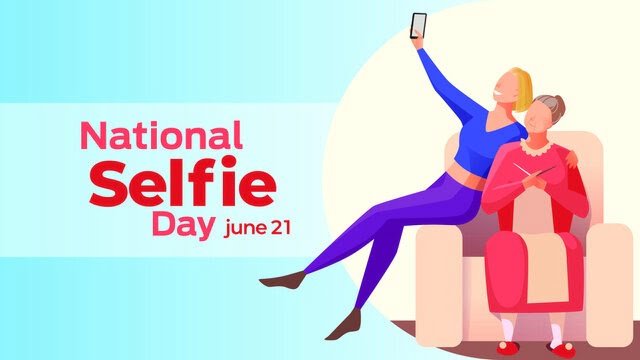Introduction to National Selfie Day
National Selfie Day, observed on June 21, offers a unique occasion to celebrate the art of self-portraiture. This day provides an opportunity for individuals to capture their best angles, experiment with new filters, and display their personal style or mood. Initially popularized with the advent of smartphones and social media platforms, the selfie has evolved into a significant cultural phenomenon.
The term “selfie” was first coined in 2002 by an Australian man who shared a self-portrait online, and it quickly gained traction worldwide. Over the years, the practice of taking selfies has become an integral part of digital communication, allowing people to express themselves visually and share moments instantly. With the advent of front-facing cameras and the proliferation of social media, the selfie has transcended mere photography, becoming a form of self-expression and personal branding.
National Selfie Day not only encourages capturing and sharing self-portraits but also highlights the technological advancements that have made this possible. From high-resolution cameras to sophisticated editing apps, modern technology has significantly enhanced the quality and creativity of selfies. This evolution reflects broader changes in how we interact with technology and each other, making the selfie a symbol of our digital age.
Moreover, selfies have played a pivotal role in shaping contemporary culture. They allow individuals to document their lives, celebrate milestones, and connect with others across the globe. Whether it’s a snapshot of a new outfit, a candid moment with friends, or a carefully curated image showcasing a picturesque location, selfies have become a staple in our visual storytelling repertoire.
As we embrace National Selfie Day, we recognize the selfie’s journey from a simple self-portrait to a powerful tool for communication and self-expression. This day invites everyone to participate, capture their essence, and share their unique perspectives with the world.
The Historical Roots of the Selfie
Self-portraiture, a unique form of artistic expression, has been integral to human creativity since the invention of the film camera in 1885. The desire to capture and immortalize one’s own image has been evident throughout history, with significant milestones marking its evolution. One of the earliest notable instances of self-portraiture was Robert Cornelius’s groundbreaking self-portrait in 1839, utilizing the daguerreotype method. This pioneering effort set the stage for a longstanding fascination with self-representation.
The daguerreotype, an early photographic process, allowed for unprecedented detail and clarity, enabling individuals like Cornelius to experiment with self-imaging. This technological advancement ignited a wave of interest in self-portraiture. As photography evolved, so did the methods and mediums through which people could capture their likenesses. The introduction of the Kodak camera in the late 19th century democratized photography, making it accessible to the general public and further popularizing self-portraits.
Throughout the 20th century, self-portraiture continued to evolve alongside advancements in photographic technology. The advent of the Polaroid camera in the 1940s brought instant photography into the mainstream, allowing people to see their self-portraits immediately. This immediacy fostered a new level of engagement and experimentation with self-imaging, paving the way for modern selfie culture.
The transition from film to digital photography in the late 20th and early 21st centuries marked a significant turning point. Digital cameras and smartphones equipped with front-facing cameras revolutionized self-portraiture, making it more convenient and accessible than ever before. The rise of social media platforms further amplified this trend, transforming selfies into a cultural phenomenon. Today, taking a selfie is not just about capturing an image; it’s about sharing a moment, expressing identity, and connecting with others.
From Robert Cornelius’s early daguerreotype self-portrait to the ubiquitous smartphone selfie, the journey of self-portraiture underscores a timeless human desire for self-expression and connection. This historical context enriches our understanding and appreciation of the modern selfie, highlighting its deep-rooted significance in the tapestry of human creativity.
The Rise of Digital Photography
The transition from film to digital photography in the 1990s and early 2000s marked a significant turning point in the way we capture and share images. Digital photography revolutionized self-portraiture by making it more accessible and affordable. The elimination of film costs and the instant feedback provided by digital cameras encouraged creativity and experimentation, allowing users to take numerous shots without worrying about the expense of development. This newfound freedom meant that people could explore different angles, lighting conditions, and expressions until they achieved the perfect selfie.
Moreover, digital photography’s ease of use and instant development capabilities democratized self-portraiture. Previously, taking a self-portrait required specialized equipment and skills, but digital cameras simplified the process, enabling anyone with a camera to participate. This accessibility was further enhanced by the advent of smartphones, which came equipped with high-quality cameras and user-friendly interfaces. As a result, selfies became a mainstream activity, embraced by people of all ages and backgrounds.
Sharing selfies also became more straightforward with the rise of social media platforms. Websites like Facebook, Instagram, and Snapchat provided a space where users could instantly share their self-portraits with a global audience. The social aspect of these platforms encouraged users to take more selfies, often incorporating creative elements like filters, stickers, and editing tools. This interaction fostered a sense of community and competition, driving individuals to continually improve their selfie game.
The impact of digital photography on self-portraiture is profound, as it has transformed a once niche activity into a ubiquitous form of expression. The ability to instantly capture and share moments has made selfies an integral part of modern communication, reflecting personal identity and social connection. With ongoing advancements in camera technology and editing software, the future of digital self-portraiture promises even greater possibilities for creativity and self-expression.
The Convergence of Camera Phones and Social Media
Around the mid-2000s, the convergence of camera phones, digital cameras, and social media platforms heralded a transformative period for the modern selfie phenomenon. As camera technology advanced, the integration of high-quality lenses in mobile phones became more commonplace, making it easier for individuals to capture moments instantaneously. The availability of these camera phones democratized photography by putting powerful imaging tools directly in the hands of millions, thereby laying the groundwork for the selfie to evolve from a niche hobby into a widespread cultural practice.
Simultaneously, the rise of social media platforms like Facebook, MySpace, and later Instagram, provided a stage for these self-portraits to be shared widely. The real-time sharing capabilities and interactive features of social media amplified the reach and impact of selfies. Platforms began to prioritize visual content, making images central to user engagement and communication. This shift encouraged users to document their lives through photographs, thus normalizing and popularizing the act of taking selfies.
Social media also played a pivotal role in evolving the art of the selfie. Hashtags, filters, and editing tools became integral components of the selfie culture, allowing individuals to enhance and personalize their photographs. The concept of ‘selfie challenges’ and viral trends emerged, fostering a sense of community and participation among users worldwide. Celebrities and influencers further propelled the selfie into mainstream consciousness by consistently sharing their self-portraits, thus setting trends and influencing public perceptions of beauty and self-expression.
This technological convergence not only democratized the creation and dissemination of selfies but also redefined visual communication in the digital age. The selfie has since become a powerful tool for self-representation, enabling individuals to craft their identities and share their narratives with a global audience.
From Robert Cornelius to Modern Artists
The journey of the selfie begins with Robert Cornelius, who is credited with taking the first self-portrait photograph in 1839. This pioneering moment laid the groundwork for what would become a significant cultural phenomenon. Over the years, various artists have redefined the genre of self-portraiture, each contributing uniquely to its evolution.
Vivian Maier, a nanny and street photographer, left an indelible mark on self-portraiture. Her work, discovered posthumously, features a series of reflective self-portraits that capture her in the midst of urban life. Maier’s introspective approach and use of reflections brought a new dimension to the concept of self-portraits, emphasizing the environment and context around the subject.
Andy Warhol, another influential figure, approached self-portraiture with a distinct flair characteristic of his pop art style. Warhol’s self-portraits went beyond mere representation; they became a commentary on identity and celebrity culture. His use of bright colors and repetitive imagery challenged traditional notions and encouraged viewers to think critically about the nature of self-representation.
In addition to these well-known figures, lesser-known artists have also made significant contributions to the evolution of self-portraiture. For instance, Francesca Woodman’s haunting black-and-white self-portraits explored themes of identity and existence, often pushing the boundaries of the genre. Her work, though not widely recognized during her lifetime, has since gained acclaim for its depth and originality.
These artists, along with countless others, have collectively shaped contemporary selfie culture. By experimenting with different techniques and perspectives, they have expanded the possibilities of self-portraiture. Today’s selfie, often taken with a smartphone and shared instantly on social media, owes much to the artistic explorations of these pioneers. Their influence is evident in the way modern selfies continue to explore identity, context, and self-expression.
Selfies as a Means of Communication
In the contemporary digital landscape, selfies have emerged as a ubiquitous form of communication, transcending the mere act of photo-taking to become a powerful tool for visual expression. From social interactions to personal branding, selfies offer an immediate and intimate way for individuals to share moments of their lives, convey emotions, and connect with others.
On a personal level, selfies are often used to capture and share everyday experiences, from mundane activities to significant life events. This visual form of communication allows people to stay connected with friends and family, offering a glimpse into their daily lives. The ease of sharing selfies on social media platforms like Instagram, Facebook, and Snapchat has made it effortless for individuals to maintain relationships and foster a sense of community.
In the realm of personal branding, selfies play an influential role. For influencers, celebrities, and professionals, a well-crafted selfie can serve as a powerful marketing tool. It enables them to cultivate their image, engage with their audience, and promote their personal brand. The authenticity and relatability conveyed through selfies can enhance followers’ loyalty and trust, making it an effective strategy in personal branding.
Moreover, selfies have also found their place in various fields such as marketing, entertainment, and business. Brands and companies leverage selfies in their marketing campaigns to create a personal connection with their audience. User-generated content, often in the form of selfies, is utilized to promote products and services, creating a sense of authenticity and trustworthiness. In the entertainment industry, celebrities and public figures use selfies to provide fans with behind-the-scenes glimpses, building a more personal connection.
In the business world, professionals use selfies to humanize their brand, showcasing the people behind the company and creating a more relatable image. This approach helps in building trust and rapport with clients and customers, ultimately benefiting the business.
Overall, selfies have transcended their original purpose, becoming a versatile and dynamic means of communication. Their integration into various aspects of everyday life highlights their significance in the modern era.
Tips for Taking the Perfect Selfie
National Selfie Day is the ideal occasion to hone your selfie skills, ensuring your self-portraits are both captivating and visually appealing. Mastering the art of the perfect selfie begins with understanding the fundamentals of lighting. Natural light is your best ally; it softens features and reduces shadows, creating a flattering effect. Position yourself near a window or outdoors during the golden hour—shortly after sunrise or before sunset—for the most favorable lighting conditions.
Angles play a crucial role in the success of your selfie. Experiment with various positions to find the most flattering angle for your face. Tilting your head slightly and holding the camera slightly above eye level can enhance your features and provide a more dynamic composition. Avoid direct head-on shots, as they can sometimes appear unflattering.
Filters can be a fun and effective way to enhance your selfies, but moderation is key. Subtle filters that enhance colors or add a touch of brightness can make your selfie pop without making it look overly edited. Many photo-editing apps offer a range of filters and adjustments; explore these options to find the perfect balance for your image.
The background of your selfie is equally important. A cluttered or distracting background can detract from the main subject—you. Opt for simple, clean backgrounds that complement your appearance without overwhelming the photo. Scenic backgrounds or walls with interesting textures can add a unique touch to your selfies without drawing attention away from you.
Composition is another vital aspect of taking a great selfie. Use the rule of thirds by positioning yourself slightly off-center. This technique creates a more balanced and engaging photo. Additionally, ensure that your entire face is visible and that important elements are not cropped out of the frame.
By focusing on these tips—lighting, angles, filters, background, and composition—you can elevate your selfie game and celebrate National Selfie Day with confidence. Embrace the process, experiment with different techniques, and most importantly, have fun capturing your best self!
The Future of Self-Portraiture
As we look to the future, the art of self-portraiture is poised to undergo a remarkable transformation driven by technological advancements. Emerging technologies such as artificial intelligence (AI), augmented reality (AR), and improved camera capabilities are set to redefine how we capture and share selfies.
AI is already making waves in photography, and its impact on self-portraiture will only grow. Advanced AI algorithms can now enhance photo quality, suggest optimal angles, and even generate entirely new backgrounds, turning a simple selfie into a professional-grade image. These intelligent systems learn from user preferences, making personalized recommendations that cater to individual styles and aesthetics.
Augmented reality is another game-changer in the realm of selfies. With AR, users can overlay digital elements onto their images in real-time. From playful filters to immersive environments, AR allows for an unprecedented level of creativity and customization. Imagine taking a selfie that places you in a famous painting, or adds virtual makeup that adjusts perfectly to your facial features. Such innovations are not only fun but also open up new avenues for self-expression.
Furthermore, the integration of 5G technology will enhance the speed and quality of sharing selfies. High-resolution images and real-time video streaming will become more accessible, making it easier to share moments instantaneously with a global audience. Social media platforms are already adapting to these changes, offering tools that leverage these technologies to provide users with richer, more interactive experiences.
In addition to these advancements, we can anticipate improvements in hardware. Future smartphones will likely feature cameras with even higher resolutions, better low-light performance, and enhanced stabilization. These enhancements will make capturing the perfect selfie easier than ever before, regardless of the environment or lighting conditions.
Ultimately, the future of self-portraiture is bright and boundless. As technology continues to evolve, so too will the ways in which we capture and share our images, making each selfie an opportunity for artistic innovation and personal expression.

























